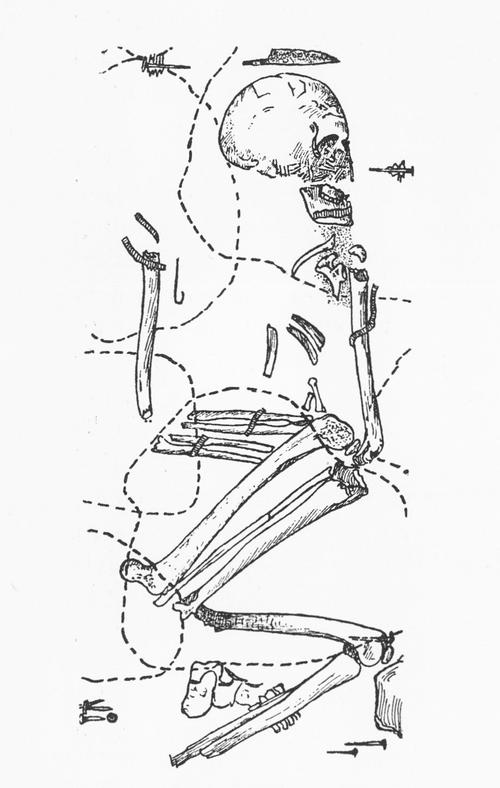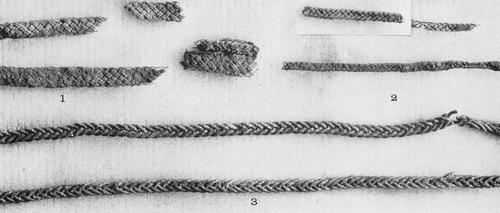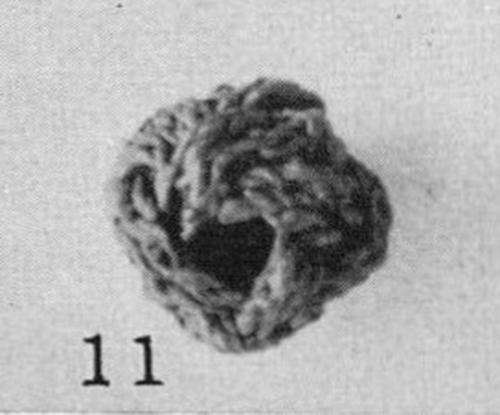Birka III. Die Textilfunde aus den Gräbern
Agnes Geijer
- Title
- Birka III. Die Textilfunde aus den Gräbern
- Original Language
- DE
- Author
- Agnes Geijer
- Year
- 1938
- Publisher
- Almqvist & Wiksell
- Website
- Open external link
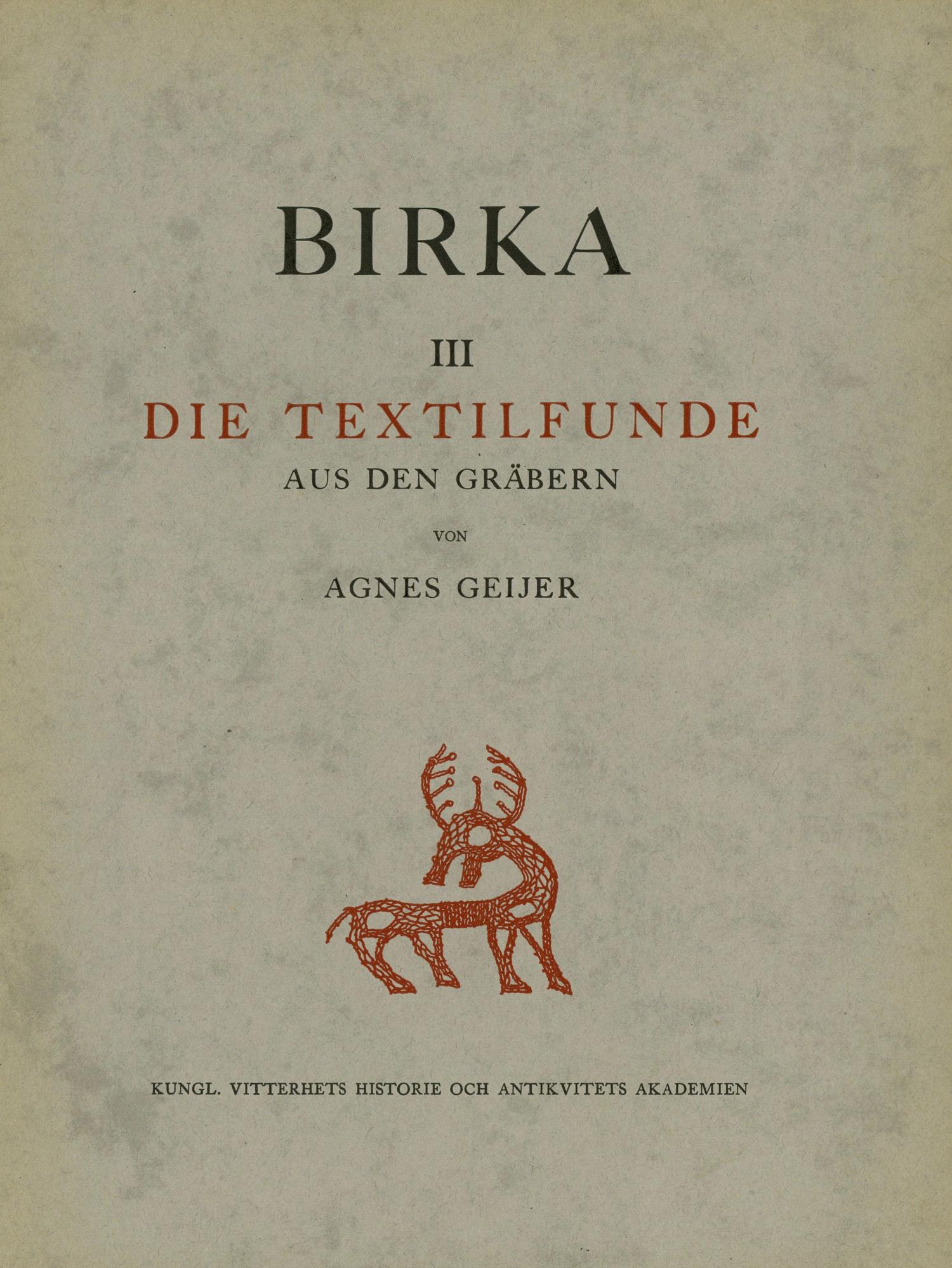
Posaments
P1 P2 P3 P4 P5 P6 P7 P8 P9 P10 P11 P12 P13 P14 P15 P16 P17 P18 P19 P20 P21 P22 P23 P24 P25 P26 P27Graves
Bj 798 Bj 886 Bj 644 Bj 542 Bj 710 Bj 524 Bj 736 Bj 643 Bj 520 Bj 957 Bj 832 Bj 944 Bj 561 Bj 327 Bj 557 Vangsnes Rolvsöy Bj 58A Bj 112A Bj 400B Bj 408 Bj 427 Bj 138B Bj 159 Bj 181 Bj 326 Bj 329 Bj 361 Bj 619 Bj 739 Bj 750 Bj 752 Bj 757 Bj 838 Bj 840 Bj 842 Bj 925 Bj 956 Bj 958 Bj 966 Bj 976 Bj 983 Bj 989A Bj 1040 Bj 1125B Bj 1151Images
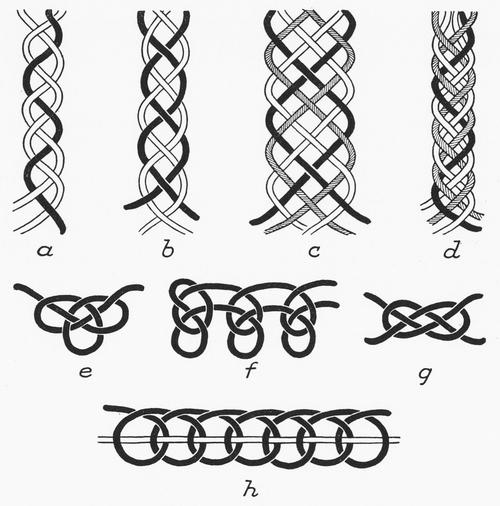
No grave association
Image details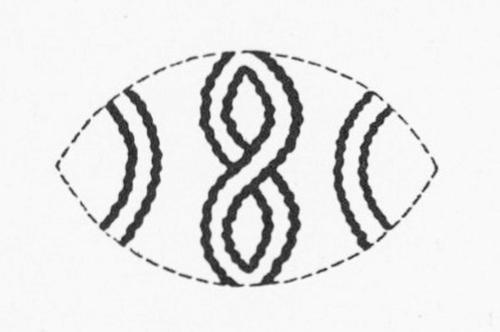
No grave association
Image details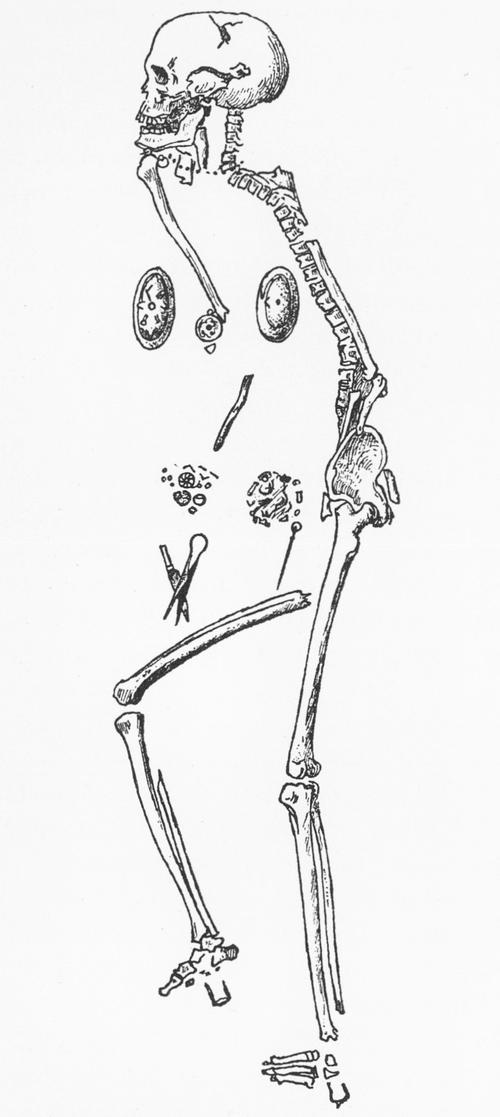
From Grave: Bj 966
Image details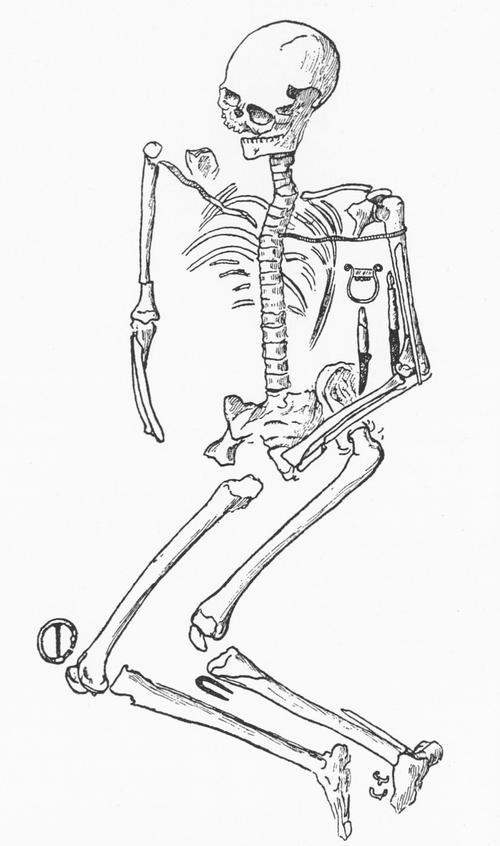
From Grave: Bj 958
Image details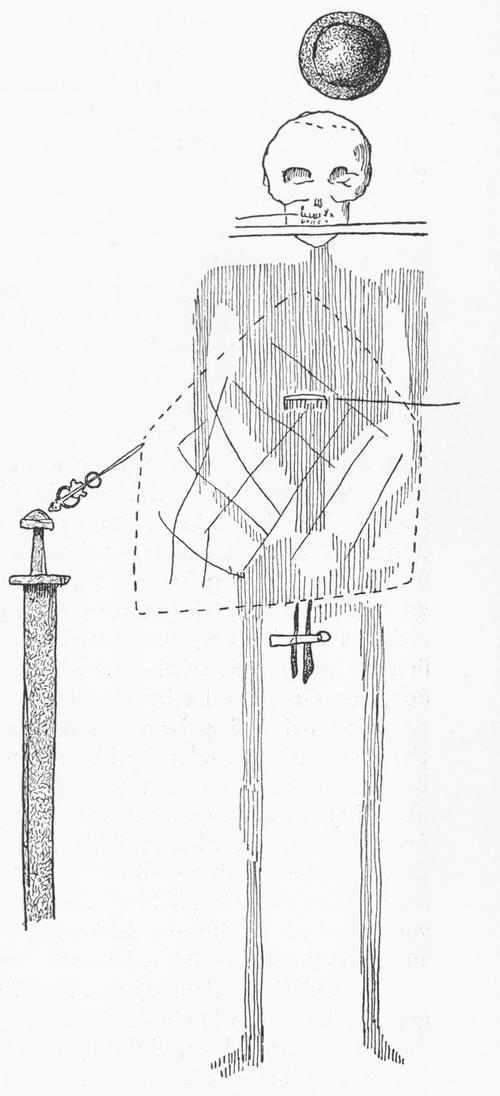
From Grave: Bj 561
Image details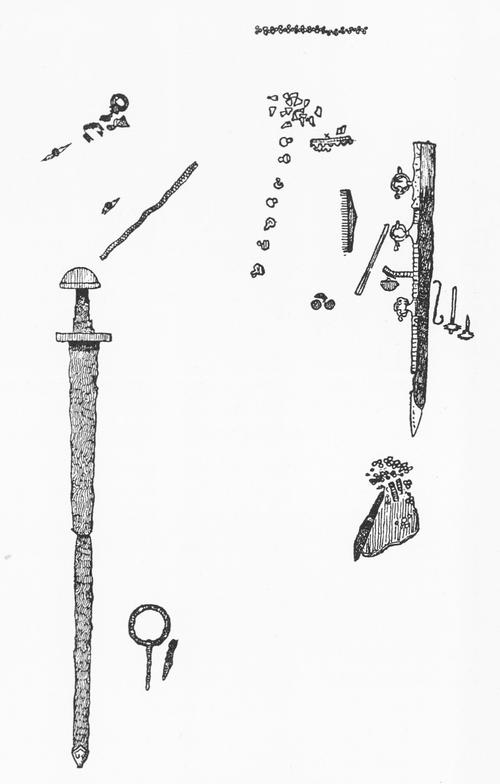
From Grave: Bj 944
Image details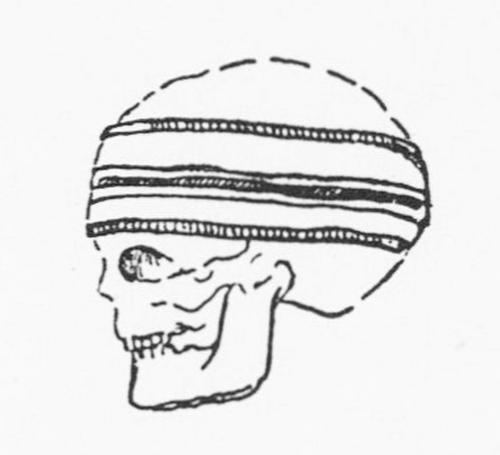
From Grave: Bj 798
Image details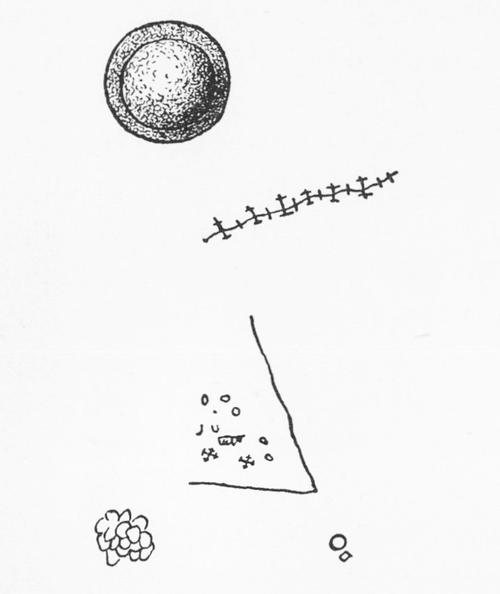
From Grave: Bj 524
Image details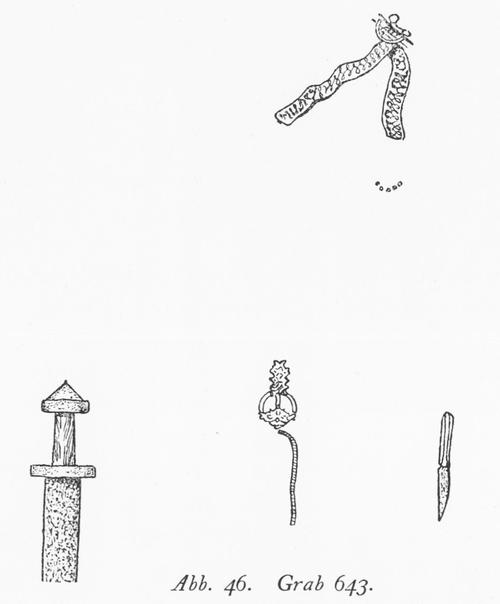
From Grave: Bj 643
Image details
From Grave: Bj 520
Image details
From Grave: Bj 832
Image details
From Grave: Bj 736
Image details
From Grave: Bj 524
Image details
From Grave: Bj 542
Image details
From Grave: Bj 644
Image details
From Grave: Bj 710
Image details
From Grave: Bj 957
Image details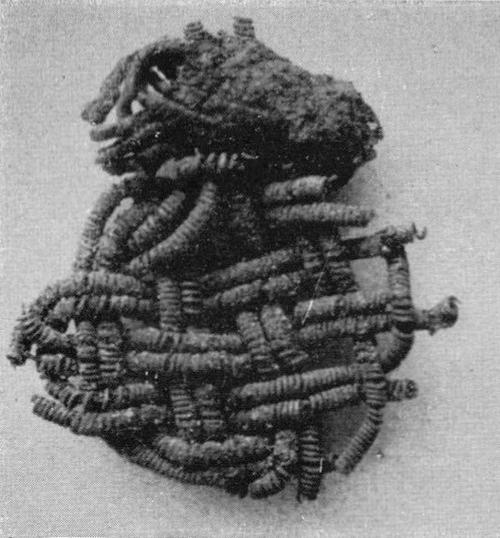
From Grave: Bj 1125B
Image details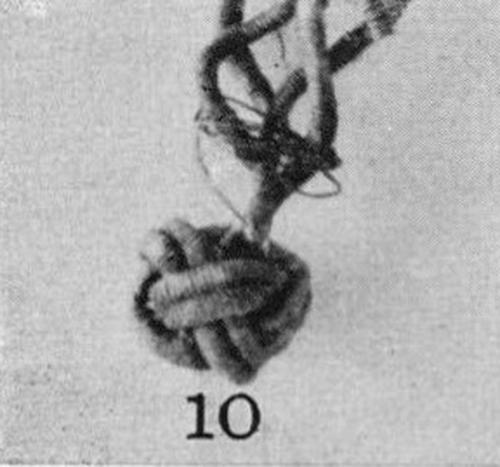
From Grave: Bj 989A
Image details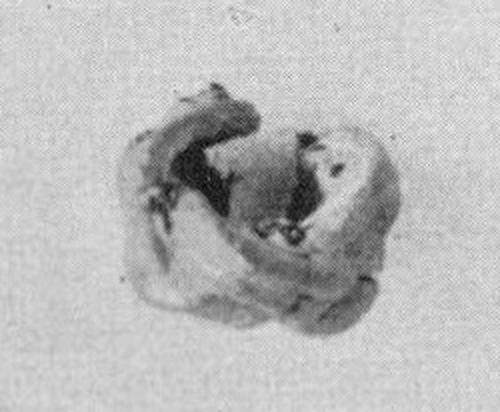
From Grave: Bj 181
Image details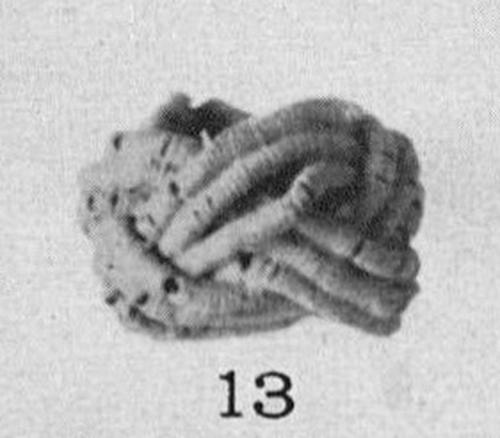
From Grave: Bj 327
Image details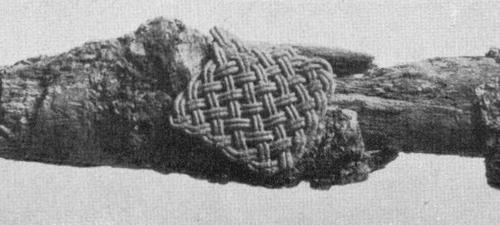
From Grave: Bj 832
Image details
From Grave: Bj 520
Image details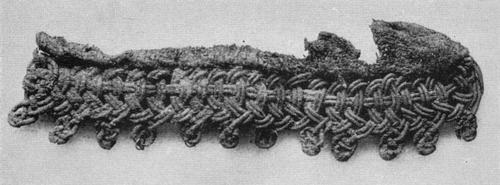
From Grave: Bj 944
Image details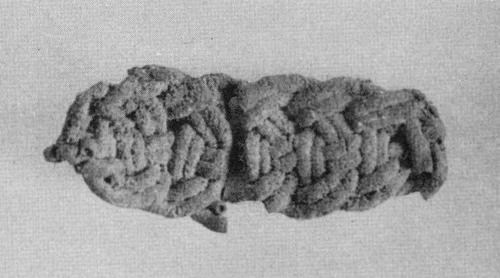
From Grave: Bj 1040
Image details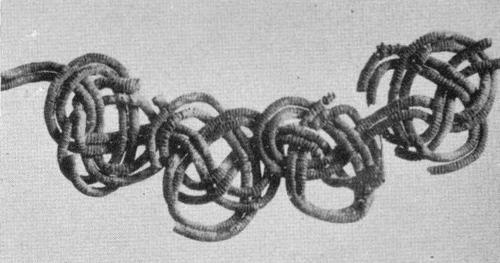
From Grave: Bj 643
Image details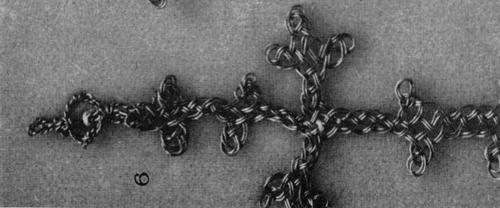
From Grave: Bj 524
Image details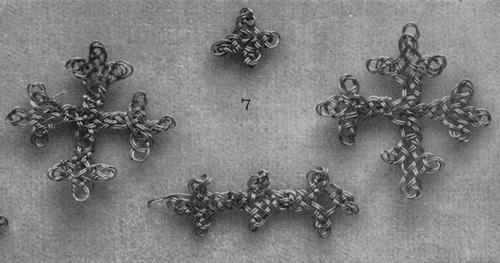
From Grave: Bj 524
Image details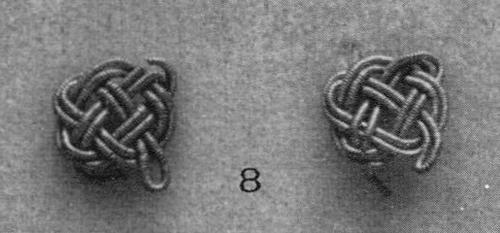
From Grave: Bj 561
Image details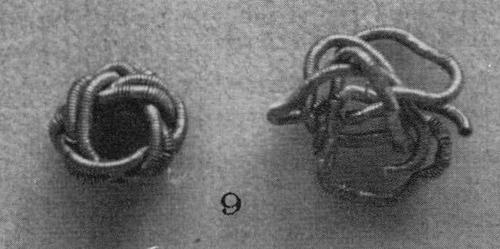
From Grave: Bj 561
Image details
From Grave: Bj 944
Image details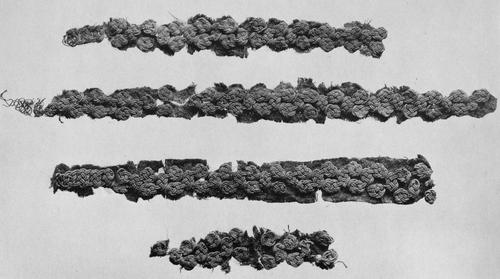
From Grave: Bj 944
Image details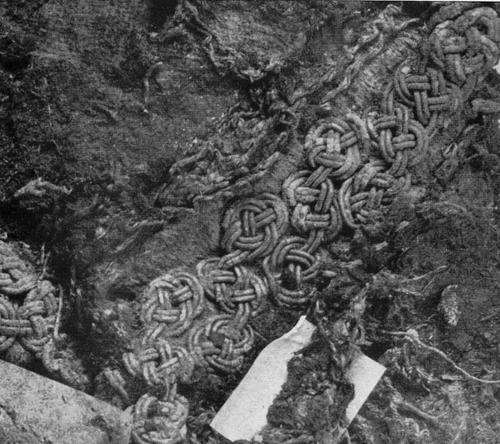
From Grave: Bj 944
Image details
From Grave: Bj 557
Image details
From Grave: Bj 832
Image details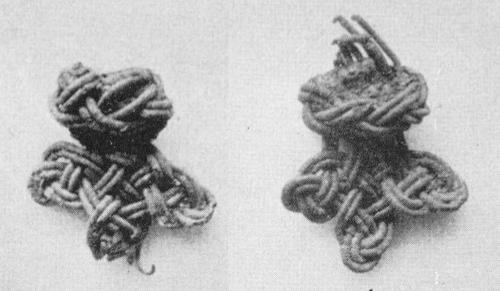
From Grave: Bj 524
Image details
From Grave: Bj 944
Image details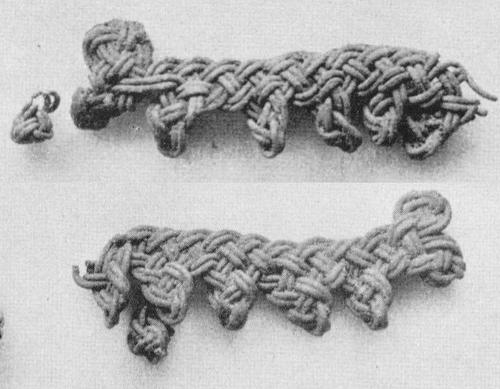
From Grave: Bj 524
Image details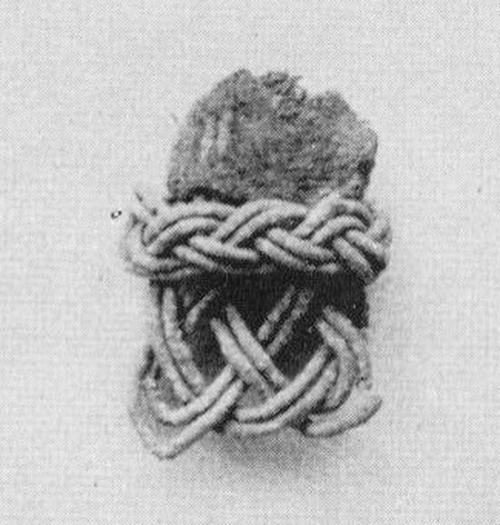
From Grave: Bj 524
Image details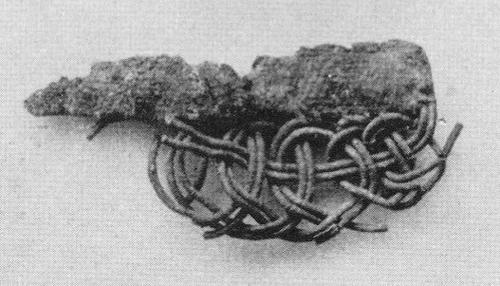
From Grave: Bj 524
Image details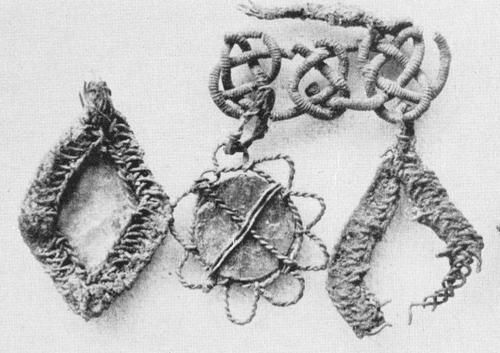
From Grave: Bj 524
Image details
From Grave: Bj 832
Image detailsTexts from this Source
Original text (DE):
P 1. GRAB 798. Taf. 26: 2. Flechtenschnur, flache Flechtung aus 5 Parten, ungefähr wie Abb. 21 b u. c. Feiner Spiralsilberdraht, einer in jedem Part. Breite 2 min, grösstes Stück 7 cm, im übrigen kleine Fragmente. Lag mit P 2 beisammen, mit dem es teilweise zusammengeklebt war, neben dem Fragment einer unbestimmbaren Stoffunterlage. Das Silber ist stark oxydiert, sodass stellenweise nur der Seidenkern übrig geblieben ist.
English translation (AI generated):
P 1. GRAVE 798. Plate 26: 2. Braided cord, flat braiding of 5 parts, approximately like Fig. 21 b and c. Fine spiral silver wire, one in each part. Width 2 mm, largest piece 7 cm, otherwise small fragments. Lay together with P 2, to which it was partially glued, next to the fragment of an indeterminable fabric base. The silver is heavily oxidized, so that in some places only the silk core remains.
Original text (DE):
P 2. GRAB 798. Taf. 26: I. Flechtenschnur aus sechs Parten in flacher Flechtung, Abb. 21 c. Feiner Spiralsilberdraht, doppelt, d. h. zwei in jedem Part. Breite ca. 4 mm. Fragmente von 2 - 3 cm Länge und darunter. Siehe vorhergehende Nummer.
English translation (AI generated):
P 2. GRAVE 798. Plate 26: I. Braided cord of six parts in flat braiding, Fig. 21 c. Fine spiral silver wire, double, i.e., two in each part. Width approx. 4 mm. Fragments of 2-3 cm length and smaller. See previous number.
Original text (DE):
P 3. GRAB 886. Taf. 26: 3. Flechtenschnur, hergestellt aus 5 Parten wie aus Abb. 21 d hervorgeht. Ziemlich grober Spiralsilberdraht, einfach. Breite 2 1/2mm. Erhalten sind 5 Teilstücke zu 6-12 cm sowie kleinere Frag- mente.
English translation (AI generated):
P 3. GRAVE 886. Plate 26: 3. Braided cord, made from 5 parts as shown in Fig. 21 d. Rather coarse spiral silver wire, single. Width 2 1/2mm. Preserved are 5 sections of 6-12 cm as well as smaller fragments.
Original text (DE):
P 4. GRAB 644. Taf. 27: 4. Flechtenschnur, bestehend aus einer vierfachen Flechte mit einfachen Ausläufern. Grober Golddraht, doppelt. An vier Stellen ist der Draht derartig angestückelt, dass die Enden zwei bis drei Mal miteinander verschlungen wurden. Die Flechtenschnur ist kunstlos durch Umbiegen der Flechte abgeschlossen. Die Flechte trägt hier und da deutliche Merkmale von Schlägen oder Reibung, wodurch der Glanz des Goldes erhöht wurde. Breite 1.3-1.5 mm, Länge (vollständig) 26 cm.
English translation (AI generated):
P 4. GRAVE 644. Plate 27: 4. Braided cord, consisting of a quadruple braid with simple extensions. Coarse gold wire, doubled. At four points, the wire is joined in such a way that the ends were twisted together two to three times. The braided cord is artlessly finished by bending the braid. The braid bears clear marks of hammering or friction here and there, which enhanced the shine of the gold. Width 1.3-1.5 mm, length (complete) 26 cm.
Original text (DE):
P 5. GRAB 542. Taf. 27: 3. Flechtenborte, bestehend aus einer vierfachen Flechte mit einfachen Ausläufern gleich den vorhergehenden, am Anfang jedoch auch ein paar kreuzförmige Ausläufer. Doppelter Golddraht, an vier Stellen wie der vorhergehende angestückelt. Sorgfältig mit einigen besonderen Verschlingungen abgeschlossen. Ebenfalls nachträglich abgeplattet. Breite mit den Ausläufern 8 bzw. 9 mm, Länge (vollständig) 27 cm.
English translation (AI generated):
P 5. GRAVE 542. Plate 27: 3. Braided border, consisting of a quadruple braid with simple extensions similar to the preceding ones, however at the beginning also a few cross-shaped extensions. Double gold wire, pieced together at four points like the preceding one. Carefully finished with some special interlacings. Also subsequently flattened. Width with the extensions 8 or 9 mm, length (complete) 27 cm.
Original text (DE):
P 6. GRAB 710. Taf. 27: 5. Flechtenborte, bestehend aus einer vierfachen Flechte mit einfachen Ausläufern, sowie 1 Paar kreuzförmigen Ausläufern am Anfang. Silberdraht, doppelt. Die Borte ist mit groben Stichen (Seide) an einer schütteren, dünnen Seide angenäht, die teilweise gerade liegt, teilweise eine schräg verlaufende Naht hat. Breite 1.3-2.5 mm. Drei Fragmente von 8.5 (mit der Seide 10) cm, bzw. 5 und 4.5 cm Länge.
English translation (AI generated):
P 6. GRAVE 710. Plate 27: 5. Braided border, consisting of a quadruple braid with simple extensions, as well as 1 pair of cross-shaped extensions at the beginning. Silver wire, double. The border is sewn with coarse stitches (silk) to a sparse, thin silk, which partly lies straight, partly has a diagonally running seam. Width 1.3-2.5 mm. Three fragments of 8.5 (with the silk 10) cm, and 5 and 4.5 cm length.
Original text (DE):
P 7. GRAB 524. Taf. 27: 2. Flechtenborte bestehend aus einer vierfachen Flechte mit abwechselnd 2 Paar einfachen und i Paar kreuzförmigen Ausläufern. Doppelter Golddraht, an vier Stellen gestückelt. Der Anfang ist in Schlingentechnik (St 15 etc.) in Form eines Ringes und eines Stabes gearbeitet, wovon man unmittelbar zum Flechten übergegangen ist. Breite bzw. 0.9 und 2.3 cm. Länge (vollständig) 28 cm.
English translation (AI generated):
P 7. GRAVE 524. Plate 27: 2. Braided border consisting of a quadruple braid with alternating 2 pairs of simple and 1 pair of cross-shaped extensions. Double gold wire, pieced together at four points. The beginning is worked in loop technique (St 15 etc.) in the form of a ring and a rod, from which one immediately transitioned to braiding. Width 0.9 and 2.3 cm respectively. Length (complete) 28 cm.
Original text (DE):
P 8. GRAB 736. Taf. 27: I. Borte, bestehend aus 22 St. kreuzförmigen Knötchen, zusammenhängd mit 3-5 mm Abstand geflochten. Feiner Golddraht, doppelt. Die Knoten sind offenbar mit dem Hammer bearbeitet worden. Die ursprüngliche Länge lässt sich nicht bestimmen. An einer Stelle ist das Verbindungsglied gebrochen. Breite 8 mm, Gesamtlänge 23 cm.
English translation (AI generated):
P 8. GRAVE 736. Plate 27: I. Border, consisting of 22 cross-shaped knots, braided together with 3-5 mm spacing. Fine gold wire, double. The knots have apparently been worked with a hammer. The original length cannot be determined. At one point, the connecting link is broken. Width 8 mm, total length 23 cm.
Original text (DE):
P 9. GRAB 643. Taf. 28: 5. Einfache Borte aus kleinen dreieckigen Zierknötchen, Abb. 21 c. Doppelter Spiralsilberfaden. Grösste Breite 8 mm. Unabgeschlossen. Dieselbe kommt auch in Grab 832 vor.
English translation (AI generated):
P 9. GRAVE 643. Plate 28: 5. Simple border of small triangular decorative knots, Fig. 21 c. Double spiral silver thread. Maximum width 8 mm. Unfinished. The same also appears in grave 832.
Original text (DE):
P 10 a. 10 a. GRAB 520. Taf. 26:4. Knötchenborte, bestehend aus achterförmigen Zierknoten (Abb. 21 g) aneinander geknüpft. Doppelter Spiralsilberfaden, der Seidenkern teilweise erhalten. Breite 7 mm. Gesamtlänge ca. 90 cm.
English translation (AI generated):
P 10 a. 10 a. GRAVE 520. Plate 26:4. Knot border, consisting of figure-eight shaped decorative knots (Fig. 21 g) tied together. Double spiral silver thread, the silk core partially preserved. Width 7 mm. Total length approx. 90 cm.
Original text (DE):
P 10 b. GRAB 957. Taf 27: 6. Knötchenborte gleich der vorhergehenden, jedoch mit schütter verteilten Knoten. An dem einen Ende, wahrscheinlich dem Anfang der Arbeit, ein dreizipfliger Knoten, gleich P 23. Länge 24 cm, scheint vollständig zu sein.
English translation (AI generated):
P 10 b. GRAVE 957. Plate 27: 6. Knot border similar to the preceding one, but with sparsely distributed knots. At one end, probably the beginning of the work, a three-pronged knot, similar to P 23. Length 24 cm, appears to be complete.
Original text (DE):
P 10 c. GRAB 832. Taf 26: 5. Knötchenborten gleich den beiden vorhergehenden. Zusammengeknüllt in Erdklumpen und stark oxydiert. Kommt ausserdem in den Gräbern 427, 524 (vgl. St 28) und 976 vor.
English translation (AI generated):
P 10 c. GRAVE 832. Plate 26: 5. Knot borders similar to the two preceding ones. Crumpled in clumps of earth and heavily oxidized. Also appears in graves 427, 524 (cf. St 28) and 976.
Original text (DE):
P 11 a. GRAB 944. Taf. 29: 2 u. 30: 2. Knötchenborte, bestehend aus abwechselnd 2 St. dreieckigen Zierknoten und 1 achterförmigen Zierknoten, welch letzterer die beiden Parten verbindet. Dort wo die Borte schmäler wird, nur achterförmige Knoten. Spiralsilberfaden, sehr angegriffen und oxydiert. Alle Borten haben eine Unterlage aus grober Seide (S 4), welche zum grössten Teil gerade zugeschnittene, dem Augenschein nach ursprüngliche Kanten hat. Erhalten sind teils die auf Taf. 29 abgebildeten 4 Borten, jetzt auseinander gewickelt und aufmontiert, teils ein Erdklumpen, der mindestens noch ein derartiges Stoffstück enthält sowie Spuren einer Stickerei aus Seide auf einem schütteren, dünnen Stoff als Einfassung. Siehe St 2. Die Breite der Knötchenborte ungefähr 1.3 cm. Die festgenähten Borten 23, 18, 14 und 8 cm, zwei an dem einen Ende schmäler werdend.
English translation (AI generated):
P 11 a. GRAVE 944. Plate 29: 2 and 30: 2. Knot border, consisting of alternating 2 triangular decorative knots and 1 figure-eight shaped decorative knot, the latter connecting the two parts. Where the border becomes narrower, only figure-eight shaped knots. Spiral silver thread, very deteriorated and oxidized. All borders have a backing of coarse silk (S 4), which for the most part has straight-cut, apparently original edges. Preserved are partly the 4 borders shown in Plate 29, now unwound and mounted, partly a clump of earth that contains at least one more such piece of fabric as well as traces of embroidery in silk on a sparse, thin fabric as edging. See St 2. The width of the knot border approximately 1.3 cm. The sewn-on borders 23, 18, 14 and 8 cm, two becoming narrower at one end.
Original text (DE):
P 11 b. GRAB 944. Taf 29: 1. Knötchenborte gleich den vorhergehenden. Der Silberfaden ist hier besser erhalten, was möglicherweise auf einer anderen Lage im Grabe beruhen kann. Sie wird nach dem einen Ende zu schmäler, wobei man zuerst 2 Mal die dreieckigen Zierknoten gegen ebensolche aus einfachen Fäden ausgetauscht und dann nur achterförmige Knoten geschlagen hat. Die Borte ruhte auf einem dünnen mit Bindungseffekten gemusterten Seidenstoff (S 2), an dem sie angenäht war. Breite 1.2 mm. Länge ca. 21 cm (nicht ganz zusammenhängend).
English translation (AI generated):
P 11 b. GRAVE 944. Plate 29: 1. Knot border similar to the preceding ones. The silver thread is better preserved here, which may be due to a different position in the grave. It becomes narrower toward one end, where first the triangular decorative knots were replaced twice with similar ones made of simple threads, and then only figure-eight knots were made. The border rested on a thin silk fabric patterned with binding effects (S 2), to which it was sewn. Width 1.2 mm. Length approx. 21 cm (not completely connected).
Original text (DE):
P 12. GRAB 524. Taf. 35: 5. Randborte, bestehend aus einer Reihe von Schlingen oder Halbschlägen hintereinander, die durch einen durchlaufenden, geraden Part mit einander verbunden werden (Abb. 21: h). Doppelter Spiralsilberfaden, recht grob. Breite 11 mm, Länge 3 cm. Das Gitter ist mit feinen Stichen am Saum eines Seidenstoffes angenäht. Dieselbe Borte kommt auch in den Gräbern 832 (bei dem „Goldhirsch") und 1040 (Taf. 28:4) vor, alle aus Spiralsilber.
English translation (AI generated):
P 12. GRAVE 524. Plate 35: 5. Edge border, consisting of a series of loops or half hitches in succession, which are connected to each other by a continuous, straight part (Fig. 21: h). Double spiral silver thread, quite coarse. Width 11 mm, length 3 cm. The lattice is sewn with fine stitches to the hem of a silk fabric. The same border also appears in graves 832 (near the "gold stag") and 1040 (Plate 28:4), all made of spiral silver.
Original text (DE):
P 13. GRAB 944 (?). Taf. 35: 2. Randborte aus zwei Reihen von Schlingen bestehend, die einander festhalten, Abb. 21 f. Ursprünglich hat man mit einem Part die Knoten geschlagen, die links auf dem Bilde sind. Mit beiden Parten hat man dann nach rechts fortgesetzt und abgeschlossen. Doppelter Spiralfaden. Die Randborte ist mit engen Stichen nach beiden Richtungen am Saum eines doppelt gefalteten Seidenstoffes (S 4) angenäht. Breite ohne den daranhängenden Seidenstoff 8 mm, Länge 98 mm.
English translation (AI generated):
P 13. GRAVE 944 (?). Plate 35: 2. Edge border consisting of two rows of loops that hold each other, Fig. 21 f. Originally, the knots that are on the left in the image were made with one part. Then both parts were continued to the right and finished. Double spiral thread. The edge border is sewn with tight stitches in both directions to the hem of a doubly folded silk fabric (S 4). Width without the attached silk fabric 8 mm, length 98 mm.
Original text (DE):
P 14. GRAB 524. Taf. 35: 3. Zwei Stück gleich grosse, abgepasste Randborten aus doppelten Spiralsilberfaden. Die Technik ähnelt der vorhergehenden, P 13, ist jedoch reicher, da doppelt so viele Parten in der Breite enthalten sind, wodurch eine feste Flechtpartie am oberen Rand gebildet wird. Die Arbeit an beiden Stücken wurde rechts auf dem Bild angefangen und derselbe Part ist hernach noch mehrere Male hin und her gegangen. An ein paar der Bortenspitzen hängen lose kleine, runde Knoten. Breite 10ß mm, Länge 4.2 bzw. 4..5 cm. Vermutlich stellen die beiden Randborten Abschlusszierate eines Knüpfbandes irgendwelcher Art dar. Doch ist jetzt keine Spur hiervon vorhanden.
English translation (AI generated):
P 14. GRAVE 524. Plate 35: 3. Two pieces of equally sized, fitted edge borders made of double spiral silver thread. The technique is similar to the preceding one, P 13, but is richer, as twice as many parts are contained in the width, creating a solid braided section at the upper edge. The work on both pieces was started on the right in the image, and the same part then went back and forth several more times. Small, round knots hang loosely from a few of the border tips. Width 10 mm, length 4.2 and 4.5 cm respectively. The two edge borders presumably represent decorative finishings of some kind of knotted band. However, there is now no trace of this.
Original text (DE):
P 15. GRAB 944 (?). Taf. 28: 3. Randborte, bestehend aus einer Reihe von Halbschlägen hintereinander, die durch einen gerade liegenden Part festgehalten werden, gleich P 12 (Abb. 21 h), ausserdem jedoch so, dass die beiden Fäden des Parts bei jedem zweiten Halbschlag je eine Schlinge bilden, die eine in die andere eingefädelt (gleich P 13, Abb. 21 f), sodass eine kleine flache Spitze gebildet wird. Breite 12 mm, Länge 5 bzw. 8 cm. Fragment von Köperseide längs des oberen Randes. Daneben lag ein gewöhnliches Brettchenband mit Silberschuss (ungefähr gleich B 13), doppelt zusammengenäht, so dass es dieselbe Länge wie die Randborte erhalten hat. Die beiden Stücke haben vermutlich ein Paar gebildet als Abschluss eines Knüpf- bandes oder etwas Ähnliches.
English translation (AI generated):
P 15. GRAVE 944 (?). Plate 28: 3. Edge border, consisting of a series of half hitches in succession, which are held by a straight-lying part, similar to P 12 (Fig. 21 h), but additionally in such a way that the two threads of the part form a loop at every second half hitch, one threaded into the other (similar to P 13, Fig. 21 f), so that a small flat point is formed. Width 12 mm, length 5 and 8 cm respectively. Fragment of twill silk along the upper edge. Next to it lay an ordinary tablet-woven band with silver weft (approximately similar to B 13), sewn together double, so that it has the same length as the edge border. The two pieces presumably formed a pair as the finishing of a knotted band or something similar.
Original text (DE):
P 16. GRAB 524. Taf. 28: 7. Vier Stück Zierknoten hergestellt aus doppeltem Golddraht, ähnlich wie P 7 a) Ein gleicharmiges einfaches Kreuz. 8 x 9 mm. b) Ein Stäbchen mit 3 Paar einfachen Ausläufern. 9 x 24 mm. c) 2 Stück gleicharmige Kreuze mit 1 Paar Ausläufern an jedem Arm, 22 X 23 bzw. 21 X 21 mm.
English translation (AI generated):
P 16. GRAVE 524. Plate 28: 7. Four decorative knots made of double gold wire, similar to P 7 a) A simple equal-armed cross. 8 x 9 mm. b) A small rod with 3 pairs of simple extensions. 9 x 24 mm. c) 2 equal-armed crosses with 1 pair of extensions on each arm, 22 x 23 and 21 x 21 mm respectively.
Original text (DE):
P 17. GRAB 561. Taf. 28: 8. 2 Stück viereckiger Zierknoten aus doppeltem Spiralgoldfaden hergestellt. 8 x 8 mm.
Original text (DE):
P 18. GRAB 832. Taf. 28: 14. Viereckiger Zierknoten, ungewöhnlich gross, hergestellt aus grobem doppeltem Spiralsilberfaden. War vermutlich an irgendeinem jetzt vermoderten Stoff gleich P 16 und 17 befestigt, bevor er an dem Holzgriff eines Messers anklebte. 19 x 20 mm.
English translation (AI generated):
P 18. GRAVE 832. Plate 28: 14. Square decorative knot, unusually large, made of coarse double spiral silver thread. Was presumably attached to some now decomposed fabric similar to P 16 and 17, before it stuck to the wooden handle of a knife. 19 x 20 mm.
Original text (DE):
P 19. GRAB 1125. Taf 28: 1. Abschlusszierate, aus einem grossen viereckigen Zierknoten bestehend, von dem die eine Ecke in einem genähten Seidenriemen verschwindet. Doppelter Spiralsilberfaden. 19 x 22 mm.
English translation (AI generated):
P 19. GRAVE 1125. Plate 28: 1. Decorative finishing, consisting of a large square decorative knot, of which one corner disappears into a sewn silk strap. Double spiral silver thread. 19 x 22 mm.
Original text (DE):
P 20. GRAB 520. Taf. 28: 2. Abschlusszierate, ein Paar, jeder der beiden aus zwei viereckigen Zierknoten bestehend, die durch einen kleinen, runden Knoten zusammen gehalten werden. Doppelter Spiralsilberfaden. 15 x 26 mm. Hat vermutlich den Abschluss eines genähten Knüpfbandes aus Seide gebildet.
English translation (AI generated):
P 20. GRAVE 520. Plate 28: 2. Decorative finishing, a pair, each of the two consisting of two square decorative knots, which are held together by a small, round knot. Double spiral silver thread. 15 x 26 mm. Presumably formed the end of a sewn knotted band made of silk.
Original text (DE):
P 21. GRAB 524. Taf. 35: 4. Abschlusszierat, aus einem dreieckigen Zierknoten bestehend, der in einem genähten Seidenriemen eingenäht ist (ca. 1,2 mm br.). Die Anstückelung ist durch einen geflochtenen Ring (wie P 24) verdeckt. Doppelter Spiralsilberfaden.
English translation (AI generated):
P 21. GRAVE 524. Plate 35: 4. Decorative finishing, consisting of a triangular decorative knot, which is sewn into a sewn silk strap (approx. 1.2 mm wide). The joining is concealed by a braided ring (like P 24). Double spiral silver thread.
Original text (DE):
P 22. GRAB 524. Taf 35: 1. Ein Paar Abschlusszierate aus doppeltem Spiralsilberfaden. Der Knoten ist flach in Form von Spitzen geflochten, der Randborte P 13 gleichend. Das Fadenende ist in einen schmalen genähten Riemen aus Seide eingearbeitet (S 4). Die Anstückelung durch einen Ring wie P 24 verdeckt. Masse: 18 (23) x 18 mm. 2 Stücke ganz gleich. Ein Exemplar desselben Knotens kommt in Grab 561 vor.
English translation (AI generated):
P 22. GRAVE 524. Plate 35: 1. A pair of decorative finishings made of double spiral silver thread. The knot is braided flat in the form of points, similar to the edge border P 13. The thread end is worked into a narrow sewn strap of silk (S 4). The joining is concealed by a ring like P 24. Dimensions: 18 (23) x 18 mm. 2 pieces exactly alike. An example of the same knot appears in grave 561.
Original text (DE):
P 23. GRAB 561. Taf. 28: 9. Ein Paar Gleitknoten aus Spiralgoldfaden. Der Knoten ist aus einem einzigen Faden hergestellt, der 6 Mal herumläuft und den Effekt einer dreifachen Flechte mit 2 Fäden in jedem Part hervorruft. Masse: 8 x 8 x 4 mm. Der eine unbeschädigt, der andere ganz zerfallen.
English translation (AI generated):
P 23. GRAVE 561. Plate 28: 9. A pair of sliding knots made of spiral gold thread. The knot is made from a single thread, which runs around 6 times and creates the effect of a triple braid with 2 threads in each part. Dimensions: 8 x 8 x 4 mm. One undamaged, the other completely disintegrated.
Original text (DE):
P 24. GRAB 327. Taf. 28: 13. Gleitknoten aus Spiralsilberfaden. Hergestellt wie der vorhergehende, jedoch mit dem Effekt von 3 Fäden in jedem Part. Masse: 11 x 8 x 6 mm.
English translation (AI generated):
P 24. GRAVE 327. Plate 28: 13. Sliding knot made of spiral silver thread. Made like the preceding one, but with the effect of 3 threads in each part. Dimensions: 11 x 8 x 6 mm.
Original text (DE):
P 25. GRAB 138. Taf. 28: 11. Gleitknoten, hergestellt aus doppelgezwirntem Silberdraht, mehrmals gewickelt, sodass derselbe Effekt wie bei mehrfachen Parten entsteht. Ein derartiger Knoten kommt in Grab 138 vor.
English translation (AI generated):
P 25. GRAVE 138. Plate 28: 11. Sliding knot, made of double-twisted silver wire, wrapped multiple times, so that the same effect as with multiple parts is created. Such a knot appears in grave 138.
Original text (DE):
P 26. GRAB 989. Taf 28: 10. Abschlussknoten ebenso ausgeführt wie P 23 am Ende einer aus 4 Fäden bestehenden Schnur. Silberspiralfaden. Masse: ca. 4 x 5 mm exklusive der Schnur. Der Knoten P 23, ebenfalls in Spiralsilber ausgeführt, kommt in den Gräbern 976 und 181 vor. Rings um den Ansatz von mehreren Gehängen und Abschlusszieraten finden sich gleichartig ausgeführte Ringe (P 21-22, St 22). Aus einem Brandgrab aus Krsp. Aringsäs, Smäland (S. H. M. Inv. Nr. 19803: 5) stammt ein Endknoten gleich P 26 und ein Gleitknoten gleich P 24, beide aus Silberdraht.
English translation (AI generated):
P 26. GRAVE 989. Plate 28: 10. End knot executed in the same way as P 23 at the end of a cord consisting of 4 threads. Silver spiral thread. Dimensions: approx. 4 x 5 mm excluding the cord. The knot P 23, also executed in spiral silver, appears in graves 976 and 181. Around the base of several pendants and decorative finishings, similarly executed rings are found (P 21-22, St 22). From a cremation grave from parish Aringsäs, Småland (S. H. M. Inv. No. 19803: 5) comes an end knot similar to P 26 and a sliding knot similar to P 24, both made of silver wire.
Original text (DE):
P 27. GRAB 557. Taf. 33: 6. Abb. 22. 3 Stücke von einem Ornament aus Goldfaden, die vermutlich um irgendeinen spulenförmigen Körper befestigt waren, wie die Zeichnung zeigt. Das Material ist gesponnener Goldfaden, woraus gewöhnliche, dreifache Flechten mit doppelten Parten gemacht wurden. Daraus wurden 2 gleich grosse, halbflache Ringe gebildet sowie ein grösserer Ring, wo die Flechte in doppelten Schlingen gelegt wurde, die einander überkreuzen. Die Stückelung ist recht einfach. Der Durchmesser der kleinen Ringe 9 mm. Der grössere ist verbeult und an der Stückelung gelockert, weshalb die Masse kaum bestimmt werden können.
English translation (AI generated):
P 27. GRAVE 557. Plate 33: 6. Fig. 22. 3 pieces of an ornament made of gold thread, which were presumably attached around some spool-shaped body, as the drawing shows. The material is spun gold thread, from which ordinary, triple braids with double parts were made. From this, 2 equally sized, semi-flat rings were formed as well as a larger ring, where the braid was laid in double loops that cross each other. The joining is quite simple. The diameter of the small rings 9 mm. The larger one is dented and loosened at the joining, which is why the dimensions can hardly be determined.
Original text (DE):
Der eine norwegische Fund, ein fragmentarisches Diadem gleich P 4, ist aus Vangsnes, prov. Sogn och Fjordane, und wird im Museum von Bergen aufbewahrt.
English translation (AI generated):
The Norwegian find, a fragmentary diadem similar to P 4, is from Vangsnes, province Sogn och Fjordane, and is kept in the Museum of Bergen.
Original text (DE):
Das andere ist zu Grunde gegangen; es gehörte zu dem 1864 entdeckten Rolvsöyfund, der aber leider unvollständig gesammelt wurde. Im Jahr 1867 beobachtete Rygh einige Goldfäden, dem Aussehen nach wie Fransen, und kleine Knäuel von Goldfäden. Siehe A.W. BRÖGGER, Rolvsöyætten, in Bergens Museums Aarbok 1920 - 21, S. 23.
English translation (AI generated):
The other has been lost; it belonged to the Rolvsøy find discovered in 1864, which unfortunately was incompletely collected. In 1867, Rygh observed some gold threads, appearing like fringes, and small bundles of gold threads. See A.W. BRÖGGER, Rolvsøyætten, in Bergens Museums Aarbok 1920 - 21, p. 23.
Original text (DE):
GRAB 58 A. M. 9.Jhdt. Unbedeutende Reste von Silberband; Knötchenborte aus Silber, P 9, 5 cm. Unter der Hufeisenfibel Reste von grobem Wollstoff ähnlich W 6.
English translation (AI generated):
GRAVE 58 A. Male. 9th century. Insignificant remains of silver band; small knot border made of silver, P 9, 5 cm. Under the horseshoe fibula remains of coarse woolen fabric similar to W 6.
Original text (DE):
GRAB 112 A. M. Brandgr. Gleitknoten aus Spiralsilber gleich P 23, obwohl weiter. Zerkrümelter Silberdraht, wahrscheinlich Reste eines gleichen Ringes.
English translation (AI generated):
GRAVE 112 A. Male. Cremation grave. Sliding knot made of spiral silver similar to P 23, although wider. Crumbled silver wire, probably remains of a similar ring.
Original text (DE):
GRAB 400 B. Brandgr. Reste eines Spiralsilberfadens, teilweise kleine Zierknoten bildend. Kann möglicherweise eine Knötchenborte wie P 9 oder P 11 gebildet haben. Lag ungefähr in der Mitte des Grabes auf zwei Stellen in Abständen von ungef. 60 cm.
English translation (AI generated):
GRAVE 400 B. Cremation grave. Remains of a spiral silver thread, partially forming small decorative knots. May possibly have formed a small knot border like P 9 or P 11. Located approximately in the middle of the grave at two points at distances of approx. 60 cm.
Original text (DE):
GRAB 408. Brandgr. Zwei runde, flache Knoten aus Spiralsilber, am ähnlichsten P 9; beide beschädigt. Silberschuss eines Brettchenbandes.
English translation (AI generated):
GRAVE 408. Cremation grave. Two round, flat knots made of spiral silver, most similar to P 9; both damaged. Silver weft of a tablet-woven band.
Original text (DE):
GRABe 427. Brandgr. Knötchenborte aus Spiralsilber, P 11.
English translation (AI generated):
GRAVE 427. Cremation grave. Small knot border made of spiral silver, P 11.
Original text (DE):
GRAB 138 B. W. Brandgr. 10.Jhdt. Gleitknoten aus Silberdraht, P 25; Reste eines flachen Knotens gleich P 19.
English translation (AI generated):
GRAVE 138 B. Female. Cremation grave. 10th century. Sliding knot made of silver wire, P 25; remains of a flat knot similar to P 19.
Original text (DE):
GRAB 159. Brandgr. Die Hälfte eines Gleitknotens aus Spiralsilber ähnlich P 24; der Part besteht aus einer Flechte zwischen zwei geraden Fäden.
English translation (AI generated):
GRAVE 159. Cremation grave. Half of a sliding knot made of spiral silver similar to P 24; the part consists of a braid between two straight threads.
Original text (DE):
GRAB 181. Brandgr. Gleitknoten aus Spiralsilber wie P 24, dreifache Parten; vom Feuer beschädigt.
English translation (AI generated):
GRAVE 181. Cremation grave. Sliding knot made of spiral silver like P 24, triple parts; damaged by fire.
Original text (DE):
GRAB 326. Brandgr. Einzelne Knoten aus Spiralsilber, P 9, wahrscheinlich Rest einer Borte.
English translation (AI generated):
GRAVE 326. Cremation grave. Individual knots made of spiral silver, P 9, probably remains of a border/trim.
Original text (DE):
GRAB 327. Brandgr. Gleitknoten aus Spiralsilber, gleich P 24.
English translation (AI generated):
GRAVE 327. Cremation grave. Sliding knot made of spiral silver, similar to P 24.
Original text (DE):
GRAB 329. Brandgr. Fragment einer Flechte aus Spiralsilber.
English translation (AI generated):
GRAVE 329. Cremation grave. Fragment of a braid made of spiral silver.
Original text (DE):
GRAB 361. M. Brandgr. Gleitknoten aus Spiralsilber wie P 24, fragmentarisch.
English translation (AI generated):
GRAVE 361. Male. Cremation grave. Sliding knot made of spiral silver like P 24, fragmentary.
Original text (DE):
GRAB 520. M. Silberne Knötchenborte, P 10, ungef. 90 cm lang, lag mitten im Grab in weichen S-förmigen Krümmungen. Im übr. nur Schwert und Schildbuckel. Die beiden Endzierate P 20 auf dem Plan nicht angegeben.
English translation (AI generated):
GRAVE 520. Male. Silver small knot border, P 10, approx. 90 cm long, lay in the middle of the grave in soft S-shaped curves. Otherwise only sword and shield boss. The two end ornaments P 20 not indicated on the plan.
Original text (DE):
GRAB 524. M. Mitte d. 10. Jhdts. Keine Spur des Skeletts. An dem vermutlichen Platz des Kopfes geflochtenes Golddiadem, P 7. über der Brust Goldschuss eines Brettchenbandes, B 23, 35-40 cm lang, das einen spitzen Winkel bildet. Nach dem erhaltenen Gold zu urteilen (Gew. 17,53 gr.) war mehr Goldband vorhanden als der Plan ausweist. Innerhalb des Winkels sind 4 Goldkreuze, P 16, sowie „div. Silberzierate” angegeben. Es ist wohl zu bezweifeln dass alle die erhaltenen Silberzierate an dieser Stelle gesammelt lagen: nämlich 3 Borten von Stoffbändern, P 12, P 14, die letzteren ein Paar; 3 Endknoten von Stoffriemen, P 21, P 22, die letzteren i Paar; „Franse” mit runden und rhombischen Anhängern, St 3o; ein kleiner Stickereirest, St 31; ein grosser Gleitring aus Spiralsilber, St 25; ein rundes Seidenstück, S 4. Wahrscheinlich beim Schwert ein ganz verrosteter Klumpen, Leinwand und grobe Wolle, W 5, sowie gemusterten Stoff ähnlich M 7 enthaltend.
English translation (AI generated):
GRAVE 524. Male. Middle of the 10th century. No trace of the skeleton. At the presumed location of the head, a braided gold diadem, P 7. Above the chest, gold weft of a tablet-woven band, B 23, 35-40 cm long, forming an acute angle. Judging by the preserved gold (weight 17.53 g), more gold band was present than the plan indicates. Within the angle, 4 gold crosses, P 16, as well as 'various silver ornaments' are indicated. It is doubtful that all the preserved silver ornaments were collected at this location: namely 3 borders of fabric bands, P 12, P 14, the latter a pair; 3 end knots of fabric straps, P 21, P 22, the latter a pair; 'fringe' with round and rhombic pendants, St 30; a small embroidery remnant, St 31; a large sliding ring made of spiral silver, St 25; a round piece of silk, S 4. Probably near the sword, a completely rusted lump containing canvas and coarse wool, W 5, as well as patterned fabric similar to M 7.
Original text (DE):
GRAB 542. M. 9.Jhdt. Geflochtenes Golddiadem, P 5. Im Grabinhalt orientalischer Glasbecher und westeurop. Silberbeschlag.
English translation (AI generated):
GRAVE 542. Male. 9th century. Braided gold diadem, P 5. In the grave contents, an Oriental glass beaker and Western European silver fitting.
Original text (DE):
GRAB 557. W. 1.H.d.9. Jhdts. Von der Oberseite der Spangen recht bedeutende Stücke von Seide, S 4, teilweise mehrfach und zusammen- geknüllt mit auf der Unterseite angeklebten Resten von dunklem W 10, und Marderfell, Beil. II. An den Rändern sind die Seidenstücke umgebogen, woraus man erkennt dass sie an einem anderen Stoff angenäht oder auch gefüttert waren. Aus demselben Stoff auch ein schmaler Riemen genäht, der ringsum die Nadel der Spange lag, in der auch Reste von Leinenstoff vorhanden waren. Unter versch. anderen Hängezieraten ein Silberanhänger, St 14, und ähnliche Gegenstände aus Golddraht, P 27. Ein kleiner Rest zweifarbiger Wollwirkerei ähnlich M 3.
English translation (AI generated):
GRAVE 557. Female. First half of the 9th century. From the upper side of the brooches, quite significant pieces of silk, S 4, partly multiple and crumpled with remains of dark W 10 glued to the underside, and marten fur, Appendix II. At the edges, the silk pieces are folded over, from which one can see that they were sewn onto another fabric or also lined. From the same material, a narrow strap was also sewn, which lay around the needle of the brooch, in which remains of linen fabric were also present. Among various other pendant ornaments, a silver pendant, St 14, and similar objects made of gold wire, P 27. A small remnant of two-colored wool weaving similar to M 3.
Original text (DE):
GRAB 561. M. 10. Jhdt. Innerhalb eines 5-eckigen Platzes, den grössten Teil des Rumpfes bedeckend, wurden Teile von Gold- und Silberdraht gefunden, der letztere verwittert und über den ganzen Raum verstreut. Erhalten ist: Goldschuss eines Brettchenbandes, B 23, 2 Sorten; 2 flache Knoten, P 17; 2 Gleitknoten, P 23, aus Spiralgold (wahrscheinlich beim Wetzstein); Reste von Spiralsilber, die sowohl von einem Knoten wie P 22 wie auch von einer einfachen Flechte herrühren.
English translation (AI generated):
GRAVE 561. Male. 10th century. Within a pentagonal area, covering the largest part of the torso, parts of gold and silver wire were found, the latter weathered and scattered throughout the entire space. Preserved are: gold weft of a tablet-woven band, B 23, 2 types; 2 flat knots, P 17; 2 sliding knots, P 23, made of spiral gold (probably near the whetstone); remains of spiral silver, which originate both from a knot like P 22 as well as from a simple braid.
Original text (DE):
GRAB 619. W. 1.H.d.9. Jhdts. Um die Spange-Nadel Reste von Leinwand. Reste eines Biberfells (Beil. II), das auf einer Spange gelegen zu haben scheint, sowie brüchige Reste von Köperstoff, Hanf ? (FH 5). Zwei Endstücke eines Seidenriemens mit Silberknoten gleich P 22, das eine auseinander gefallen.
English translation (AI generated):
GRAVE 619. Female. First half of the 9th century. Around the brooch-pin remains of linen. Remains of beaver fur (Appendix II), which appears to have lain on a brooch, as well as fragile remains of twill fabric, hemp? (FH 5). Two end pieces of a silk strap with silver knots similar to P 22, one of them fallen apart.
Original text (DE):
GRAB 643. M. 1.H.d.10.Jhdts. Laut dem Plan lag die einfachere Hufeisenfibel an einem recht breiten, 30-40 cm langen Silberband befestigt, auf oder hinter dem Kopf; möglicherweise ein separat hineingelegter Mantel. Ein schmales Goldband, B 23, und wahrscheinlich das Silberbortenstückchen P 9 (3 cm lang) wurden bei der prachtvollen Ringnadel auf dem Körper gefunden.
English translation (AI generated):
GRAVE 643. Male. First half of the 10th century. According to the plan, the simpler horseshoe fibula was attached to a rather wide, 30-40 cm long silver band, on or behind the head; possibly a separately placed cloak. A narrow gold band, B 23, and probably the small silver border piece P 9 (3 cm long) were found with the magnificent ring pin on the body.
Original text (DE):
GRAB 644. M. u. W. in sitzender Stellung. Mitte d. 10. Jhdts. Über dem Schädel des Mannes ein Golddiadem, P 4; am Nacken Silberbeschlag einer tütenförmigen Mütze gleich Grab 581. Bei der Frau lagen zusammen mit einer Menge Gegenständen (wie Messer, Wetzstein, Feuerzeug usw.) Schuss eines Goldbandes (B 23), ungef. 25 cm lang, in einem Winkel gelegt und ein doppelseitiger Stern aus Goldblech und Silberdraht, St 27.
English translation (AI generated):
GRAVE 644. Man and woman in sitting position. Middle of the 10th century. Above the man's skull a gold diadem, P 4; at the neck silver fitting of a cone-shaped cap similar to grave 581. With the woman, together with many objects (such as knife, whetstone, fire starter, etc.), a piece of gold band (B 23), approximately 25 cm long, placed at an angle, and a double-sided star made of gold sheet and silver wire, St 27.
Original text (DE):
GRAB 710. M. 10. Jhdt. Geflochtenes Silberdiadem, P 6, auf dünner Seide angenäht. Dies ist auf dem Plan nicht angegeben, dagegen aber etwas vom Kopf entfernt ein ungef. 25 cm langes Silberband neben einigen Gewichten.
English translation (AI generated):
GRAVE 710. Male. 10th century. Braided silver diadem, P 6, sewn onto thin silk. This is not indicated on the plan, but instead, somewhat distant from the head, an approximately 25 cm long silver band next to some weights.
Original text (DE):
GRAB 736. M. 10. Jhdt. Unter dem einen Schild, vermutlich auf dem Kopf, ein Golddiadem, P 8, und einige jetzt verschwundene Stücke eines Silberbandes. Um die Hufeisenfibel Reste eines zottigen Gewebes, W 9.
English translation (AI generated):
GRAVE 736. Male. 10th century. Under one shield, presumably on the head, a gold diadem, P 8, and some now disappeared pieces of a silver band. Around the horseshoe fibula remains of a shaggy fabric, W 9.
Original text (DE):
GRAB 739. W. 10. Jhdt. In der Nähe der ovalen Spangen Wollstoff, W 10, und bei der Silberspange Seidenstreifen, S 4. Beim Schlüssel ein kleiner Rest eines Mustergewebes, M 5. An unbekannter Stelle ein relativ grosses Eckfragment einer mehrfarbigen Decke, M 2, sowie Reste von gröberen und feineren Wollstoffen, W4 und W31. Rings um die Bronzeschüssel Leinwand gleich FH 2. — Auf dem Plan sind bei der Spange oben an der Achsel 2 Endknoten aus Silberdraht gleich P 22 zu sehen, doch sind diese nicht wiederzufinden.
English translation (AI generated):
GRAVE 739. Female. 10th century. Near the oval brooches wool fabric, W 10, and by the silver brooch silk strips, S 4. By the key a small remnant of a patterned fabric, M 5. At an unknown location a relatively large corner fragment of a multicolored blanket, M 2, as well as remains of coarser and finer wool fabrics, W4 and W31. Around the bronze bowl linen similar to FH 2. — On the plan, 2 end knots made of silver wire similar to P 22 can be seen at the brooch at the top of the shoulder, but these cannot be found again.
Original text (DE):
GRAB 750. M . u. W . Mitte d. 10. Jhdts. Erhalten sind ungewöhnlich grosse Mengen Goldschuss von Brettchenband, teils B 23 (4 etwas verschiedene Sorten), teils Reste gleich B 22 mit Seidenrändern. Ausserdem Goldstickerei, St 1, ein Gleitring aus Gold, St 23, der Goldknoten St 28 und 2 Goldbleche mit Nadellöchern; die letzteren 4 Gegenstände können auf dem Plan nicht identifiziert werden. Auf dem Plan lagen an den Schultern (vielleicht auf dem Kopf) des Mannes 4 ungef. gleich lange Goldbänder, die paarweise mit einander Winkel gebildet zu haben scheinen; an dem Ende des einen Bandes ein Thorshammer aus Silber. Weiter unten am Körper liegen mehrere Bänder parallel mit dem Schwert und eins im Winkel dazu. An dem vermutlichen Platz vom Kopf der Frau eine undeutliche Markierung, mit der vielleicht ein Silberband gemeint ist, wovon kleine Reste erhalten sind, und ein Knoten aus Silberdraht in der Art P 16, der sich nicht wiederfinden lässt. Am Gürtel trug die Frau Messer, Wetzstein, gestickten Nadelbehälter, St 21, Spiegel(?) und Schelle. Neben dem Messer sind 2 „brüchige" Goldbänder mit gesponnenem Schuss angegeben, siehe B 23 a. Ganz unten am Fussende eine verworrene Ansammlung Goldschuss, darunter vielleicht auch St 1, dessen Reste bis neulich mit Bandschuss vermischt lag. In dem einen Eimer lag ein Lederbeutel aus vergoldeter Flechtarbeit, einen Denar, Gewichte und Golddraht enthaltend. über den Leichen sind wahrscheinlich Decken o. dgl. gelegen. Zusammenhängende Stücke eines zottigen Gewebes, D 11, zeigen deutliche Spuren der weiblichen Spangen. Der Thorshammer hat Abdrücke auf einem verfilzten Haarklumpen hinterlassen, der wahrscheinlich von einer Pelzdecke stammt, die wiederum noch mit einem groben Ripsgewebe ähnlich dem Grundgewebe in M 4 bedeckt gewesen war.
English translation (AI generated):
GRAVE 750. Male and Female. Middle of the 10th century. Unusually large quantities of gold weft from tablet-woven bands are preserved, partly B 23 (4 somewhat different types), partly remains similar to B 22 with silk edges. Additionally, gold embroidery, St 1, a sliding ring of gold, St 23, the gold knot St 28, and 2 gold sheets with needle holes; the latter 4 objects cannot be identified on the plan. On the plan, at the shoulders (perhaps on the head) of the man were 4 approximately equally long gold bands, which seem to have formed angles with each other in pairs; at the end of one band a Thor's hammer of silver. Further down on the body lie several bands parallel to the sword and one at an angle to it. At the presumed location of the woman's head, an indistinct marking, which may indicate a silver band of which small remains are preserved, and a knot of silver wire in the style of P 16, which cannot be found again. At the belt, the woman wore a knife, whetstone, embroidered needle case, St 21, mirror(?) and bell. Next to the knife, 2 'fragile' gold bands with spun weft are indicated, see B 23 a. At the very bottom at the foot end, a confused accumulation of gold weft, possibly including St 1, the remains of which until recently were mixed with band weft. In one of the buckets lay a leather pouch of gilded braided work, containing a denarius, weights, and gold wire. Covers or similar items probably lay over the corpses. Coherent pieces of a shaggy fabric, D 11, show clear traces of the female brooches. The Thor's hammer has left impressions on a matted clump of hair, which probably comes from a fur blanket, which in turn had been covered with a coarse rep weave similar to the base fabric in M 4.
Original text (DE):
GRAB 752. M. 10. Jhdt. 10 St. runde Bronzeknöpfe in gleichen Abständen in einer geraden Linie vom Kinn hinunter zur Gürtelschnalle. An diesen angeklebt Reste von Tierfellen, die jedoch keiner der analysierten Proben ganz ähneln. Bei der Hufeisenfibel ist auf dem Plan eine kleine Silberflechte eingezeichnet, die jedoch nicht wiederzufinden ist.
English translation (AI generated):
GRAVE 752. Male. 10th century. 10 round bronze buttons at equal distances in a straight line from the chin down to the belt buckle. Attached to these are remains of animal hides, which, however, do not completely resemble any of the analyzed samples. Near the horseshoe fibula, a small silver braid is drawn on the plan, which, however, cannot be found again.
Original text (DE):
GRAB 757. W. 10. Jhdt. In den ovalen Spangen recht viel grobe Leinwand, ein wenig feine, rote Leinwand und ein karierter Stoff, FH 7. Reste eines Stoffes ähnlich W 14 und Spiralsilberdraht, der wahrscheinlich eine auf dem Plan eingezeichnete „kreuzförmige Flechtarbeit” gebildet hat.
English translation (AI generated):
GRAVE 757. Female. 10th century. In the oval brooches, quite a lot of coarse linen, a little fine, red linen, and a checkered fabric, FH 7. Remains of a fabric similar to W 14 and spiral silver wire, which probably formed a 'cross-shaped braided work' drawn on the plan.
Original text (DE):
GRAB 798. M. Um 900. Unbedeutende Reste eines silbernen Brettchenbandes, einige Stücke von Knötchenborten gleich P 10, 2 Sorten schmale, geflochtene Silberschnüre, P 1 u. 2. Die letzten bildeten eine breite Borte rings um die Stirne und das Hinterhaupt.
English translation (AI generated):
GRAVE 798. Male. Around 900. Insignificant remains of a silver tablet-woven band, some pieces of small knot borders similar to P 10, 2 types of narrow, braided silver cords, P 1 and 2. The latter formed a wide border around the forehead and the back of the head.
Original text (DE):
GRAB 832. M. Wahrsch. um 900. Auf dem Plan (Skelett vernichtet) sind auf beiden Seiten der grossen Ringnadel (ungef. auf den Schultern) zwei identische Figuren in der Form eines A gezeichnet. Weiter oben (über dem Kopf oder am Hals) eine Reihe kleiner Knoten in der Längsrichtung. Diese Bänder sind wahrscheinlich mit den Knötchenborten aus Spiralsilber, P 10 u. P 12, zu identifizieren, die jetzt in bedeutenden Mengen zusammengeknittert in Erdklumpen liegen. Weiter unten, vielleicht am Gürtel, lag der Goldhirsch (St 16), und die „Flitter-Stickerei” St 26 nebst mehreren Glimmerstückchen. Zwischen diesen und dem Messer, woran der Silberknoten P 18 haftete, lief ein jetzt verschwundenes Band. Das auf dem Plan nicht eingezeichnete kleine Tier St 18 lag wahrscheinlich hier. Ein Klumpen enthielt Reste von Pelz.
English translation (AI generated):
GRAVE 832. M. Probably around 900. On the plan (skeleton destroyed), two identical A-shaped figures are drawn on both sides of the large ring pin (approximately on the shoulders). Further up (above the head or at the neck), a row of small knots in the longitudinal direction. These bands are probably to be identified with the knotted borders of spiral silver, P 10 and P 12, which now lie crumpled together in significant quantities in clumps of earth. Further down, perhaps at the belt, lay the gold deer (St 16), and the 'sequin embroidery' St 26 along with several pieces of mica. Between these and the knife, to which the silver knot P 18 was attached, ran a band that has now disappeared. The small animal St 18, not drawn on the plan, was probably located here. One clump contained remains of fur.
Original text (DE):
GRAB 838. W. 10. Jhdt. In den Spangen doppelte Schleifen, von vorne aus feiner Leinwand, von hinten aus gröberem Stoff. Die beiden Spangen sind deutlich infolge der Vermoderung auf den Boden des Grabs gesunken, wobei die dazwischenliegenden Schichten zum Teil erhalten wurden. Der eine Klumpen enthielt, von der Spange aus gerechnet: 1) Kantstück eines Mantels o. dgl. aus Rautenköper mit umgebogenem und gesticktem Rand (W 10 g, D 4, St 4); wie zufälligerweise unter der Spange hineingeglitten. 2) Rippe und eine dünne Schicht dunkler Masse, von dem vermoderten Körper herrührend; 3) Feiner Wollstoff, W 17, mit der Unterseite nach oben. 4) Unmittelbar daneben eine feine und ebenmässige Pelzdecke mit hellbraunem Haar, möglicherweise Marder oder Biber. 5) In der Erde unter der Decke waren rötliche Wollfäden zu sehen, deren Zusammenhang unmöglich festzustellen war. — In dem anderen Klumpen, der hauptsächlich dasselbe enthielt, lagen Reste des roten Garnes nahe an W 17. Ausserdem stark verwitterte Reste eines Silberbandes, das über der Stirn gelegen war, und von Spiralsilber eines Knotens gleich P 21.
English translation (AI generated):
GRAVE 838. F. 10th century. Double loops in the brooches, made of fine linen at the front and coarser fabric at the back. The two brooches have clearly sunk to the bottom of the grave due to decomposition, whereby the layers in between were partially preserved. One clump contained, counting from the brooch: 1) Edge piece of a cloak or similar made of diamond twill with folded and embroidered edge (W 10 g, D 4, St 4); as if accidentally slipped under the brooch. 2) Rib and a thin layer of dark matter, originating from the decomposed body; 3) Fine woolen fabric, W 17, with the underside facing up. 4) Immediately adjacent, a fine and even fur cover with light brown hair, possibly marten or beaver. 5) In the soil under the cover, reddish woolen threads were visible, whose context was impossible to determine. — In the other clump, which mainly contained the same, lay remains of the red yarn close to W 17. Additionally, heavily weathered remains of a silver band that had been positioned above the forehead, and spiral silver from a knot similar to P 21.
Original text (DE):
GRAB 840. Skelettgr. ohne aufschlussgebenden Grabinhalt. Stark verwitterte Reste eines Silberbandes und einer 4-5 cm langen Borte, P 12, was alles auf dem Plan ungefähr am Platz des Kopfes eingezeichnet ist.
English translation (AI generated):
GRAVE 840. Skeleton grave without informative grave contents. Heavily weathered remains of a silver band and a 4-5 cm long border, P 12, all of which are marked on the plan approximately at the position of the head.
Original text (DE):
GRAB 842. M. Auf dem Plan ist ein ungef. 25 cm langes „Silberband mit Glimmer” zu sehen, parallel mit dem Schwertgriff liegend, aber etwas näher dem Kopf zu. Davon sind nur undeutliche Erdklumpen mit zersetzten Überresten von gewöhnlichem Silberband und Ornamentknoten übrig.
English translation (AI generated):
GRAVE 842. Male. On the plan, an approximately 25 cm long 'silver band with mica' can be seen, lying parallel to the sword handle, but somewhat closer to the head. Of this, only indistinct clumps of earth with decomposed remains of ordinary silver band and ornamental knots remain.
Original text (DE):
GRAB 886. M. Flechtschnur aus Silber, P 3, in doppelten Reihen um den Kopf. Reste von Knoten wie P 9 aus Spiralsilber und Kreuzknoten, wie P 8, aus Silberdraht, was alles laut dem Plan auf der Brust lag. Hierher gehört wahrscheinlich die auf Seide gestickte Borte St 6, deren erhaltene Reste zusammen ungef. 75 cm betragen. Der Schwertgriff aus Holz ist mit sehr feiner, jetzt rostgefüllter Leinwand umwunden; die Stoffstreifen sind doppelt gefaltet und so sorgfältig gelegt, dass immer dieselbe Breite, 3-4 mm, frei liegt. Ausserdem waren kleine Stücke gröberer Leinwand, von der Kleidung herrührend, daran festgerostet.
English translation (AI generated):
GRAVE 886. M. Silver braided cord, P 3, in double rows around the head. Remains of knots like P 9 made of spiral silver and cross knots, like P 8, made of silver wire, all of which according to the plan lay on the chest. The embroidered border on silk St 6, whose preserved remains total approximately 75 cm, probably belongs here. The wooden sword handle is wrapped with very fine linen, now filled with rust; the fabric strips are folded double and so carefully placed that the same width, 3-4 mm, is always exposed. Additionally, small pieces of coarser linen, originating from clothing, were rusted onto it.
Original text (DE):
GRAB 925. Brandgr. Gleitknoten aus Spiralsilber gleich P 23.
English translation (AI generated):
GRAVE 925. Cremation grave. Sliding knot made of spiral silver similar to P 23.
Original text (DE):
GRAB 944. M . 10. Jhdt. Auf dem Kopf, in gerader Linie über der Stirn, silberne Knötchenborte, P 11, auf einer Unterlage gemusterter und mit Gold bemalter oder bedruckter Seide, S 3. Die Borte verdeckte eine Naht, die zwei der Form nach abgerundete Stoffstücke zusammengefügt hatte. Hiemit zusammen wurde das Fragment S 5, zusammengeknüllt und mit Spuren von zersetztem Silber, erhalten. — An der linken Schulter eine Silberborte, P 13, die Randverzierung eines 10 cm breiten, doppelseitigen Bandes aus Seide, S 4. In grossen Klumpen (auf dem Plan zwischen Hüfte und Knie) wurden Silberborten derselben Sorte erhalten, wie auf dem Kopf. Sie lagen auf Seidenstreifen, S 4, letztere als Besatz in einen dünnen, jetzt vermoderten Stoff (FH 4?) eingefasst, die mit Seide gestickt waren (St 2). Die Silberborten verschmälern sich dem Ende zu. Durch Aufweichen in Wasser konnten 4 Borten mit entspr. Seidenstreifen losgelöst werden. Der übriggebliebene Klumpen, an dem aus Rücksicht auf die Stickerei und den Stoff nicht gerührt wurde, dürfte wenigstens eine Borte enthalten. Mehrere Stücke von Silberbändern in zwei Breiten, Typen B 6-7, liegen lose oder mit P 11 zusammengeklebt. Einige Stücke sind mit Seide, 54, zusammengenäht sowohl der Länge als der Quere nach (vgl. Grab 824). Auf dem Plan liegt ein ungefähr 25 cm langes Stück von der rechten Schulter schräg nach unten und aussen gerichtet und ein Stück weiter unten links. Vorne 7 Bronzknöpfe. Die beiden Endzierate eines Seidenbandes, bestehend aus P 15 und einem doppelgefalteten Silberband, sind auf dem Plan nicht wiederzufinden.
English translation (AI generated):
GRAVE 944. M. 10th century. On the head, in a straight line above the forehead, silver knotted border, P 11, on a base of patterned silk painted or printed with gold, S 3. The border covered a seam that had joined two rounded pieces of fabric. Together with this, the fragment S 5, crumpled and with traces of decomposed silver, was preserved. — On the left shoulder a silver border, P 13, the edge decoration of a 10 cm wide, double-sided band of silk, S 4. In large clumps (on the plan between hip and knee) silver borders of the same type were preserved as on the head. They lay on silk strips, S 4, the latter set as trimming in a thin, now decomposed fabric (FH 4?) that was embroidered with silk (St 2). The silver borders narrow towards the end. By soaking in water, 4 borders with corresponding silk strips could be detached. The remaining clump, which was not disturbed out of consideration for the embroidery and the fabric, probably contains at least one border. Several pieces of silver bands in two widths, types B 6-7, lie loose or glued together with P 11. Some pieces are sewn together with silk, S4, both lengthwise and crosswise (cf. Grave 824). On the plan, a piece approximately 25 cm long extends diagonally downward and outward from the right shoulder, and another piece further down on the left. Seven bronze buttons at the front. The two end ornaments of a silk band, consisting of P 15 and a double-folded silver band, cannot be found on the plan.
Original text (DE):
GRAB 956. M. 10. Jhdt. Ganz zerrissene Fragmente von Silberbändern, auf dem Plan vertikal mitten auf der Brust eingezeichnet. Daneben ein Beutel mit Gewichten und weiter unten ein anderer, ein Feuerzeug enthaltend, aus Leder mit Silberbeschlägen und (nach Stolpe) Spuren von Goldornamenten. Der dabei liegende grobe Wollstoff, gleich W 1, dürfte von einer Decke o. dgl. herrühren. Reste eines Biberfells (Beil. II).
English translation (AI generated):
GRAVE 956. M. 10th century. Completely torn fragments of silver bands, drawn vertically in the middle of the chest on the plan. Next to it a pouch with weights and further down another one, containing a fire starter, made of leather with silver fittings and (according to Stolpe) traces of gold ornaments. The coarse woolen fabric lying nearby, similar to W 1, probably originates from a cover or similar. Remains of a beaver fur (Appendix II).
Original text (DE):
GRAB 957. M. Knötchenborte aus Silber, P 10, am einen Ende mit einem dreizipfligen Knoten schliessend — liegt auf dem Plan in einer geraden Linie über der Stirne. Mehrere sehr beschädigte Stücke von Brettchenbändern, 2 Breiten, gleich B 6-7, teilweise angenäht an Seide, S 4; auf dem Plan sind 4-5 Bänder dicht zusammen schräg über der Brust zu sehen.
English translation (AI generated):
GRAVE 957. M. Knotted border of silver, P 10, ending at one end with a three-pronged knot — lies on the plan in a straight line above the forehead. Several heavily damaged pieces of tablet-woven bands, 2 widths, similar to B 6-7, partially sewn to silk, S 4; on the plan 4-5 bands are visible close together diagonally across the chest.
Original text (DE):
GRAB 958. M. 10. Jhdt. Klarer Plan mit gut erhaltenem Skelett: quer über der Brust und, wie es scheint, rund um die Achseln ein Silberband, wovon aber nichts erhalten ist. Gleich unterhalb der linken Schulter eine Ledertasche mit hufeisenförmigem Beschlag, mit „einem kurzen geflochtenen Silberband" verziert, wovon jetzt nur violettweisser Niederschlag übrig ist. Das grobe Wollgewebe, gleich W 1, das zunächst liegt, rührt vermutlich von einer Decke oder einem Mantel her. — Ausserdem ein anderer Lederbeutel. — Die Hufeisenfibel liegt an dem einen Knie.
English translation (AI generated):
GRAVE 958. M. 10th century. Clear plan with well-preserved skeleton: across the chest and, as it appears, around the shoulders a silver band, of which nothing is preserved. Just below the left shoulder a leather pouch with horseshoe-shaped fitting, decorated with "a short braided silver band", of which now only a violet-white residue remains. The coarse woolen fabric, similar to W 1, which lies nearby, probably originates from a cover or a cloak. — Additionally another leather pouch. — The horseshoe fibula lies at one knee.
Original text (DE):
GRAB 966. W. 10. Jhdt. Nach Stolpe hat die Frau einen Beutel mit Münzen getragen, der eine jetzt verschwundene Verzierung aus Spiralsilber hatte.
English translation (AI generated):
GRAVE 966. F. 10th century. According to Stolpe, the woman wore a pouch with coins that had a now disappeared decoration made of spiral silver.
Original text (DE):
GRAB 976. M. Verworrene Reste von Silberband, ungef. B 7; Knötchenborte wie P 10 aus Silber, mindestens 15 cm. Gleitknoten aus Silber wie P 24. 3 Spiralen aus grobem Bronzedraht, wie Perlen auf eine Wollschnur aufgezogen, Masse ungef. 5 x 15 mm. — Auf dem Plan ist am Kopfende des Grabes eine S-ähnliche Figur aus dem Silberband, den Bronzespiralen und der Knötchenborte eingezeichnet.
English translation (AI generated):
GRAVE 976. M. Tangled remains of silver band, approximately B 7; knotted border like P 10 made of silver, at least 15 cm. Sliding knot of silver like P 24. 3 spirals of coarse bronze wire, strung like beads on a wool cord, dimensions approximately 5 x 15 mm. — On the plan, at the head end of the grave, an S-like figure made of the silver band, the bronze spirals, and the knotted border is drawn.
Original text (DE):
GRAB 983. W. 10. Jhdt. In den Spangen Spuren von Leinwand. Vermutlich darauf dunkler W 10 und undeutliche Reste eines groben Gewebes wie W I. Mit ungewisser Lage kleine Stücke von schmalen Seidenriemen, verschiedene Knoten aus Spiralsilber und ein Fragment von gezwirnten Wollfäden, die ein Brettchenband, B 28, gebildet zu haben scheinen, vermutl. mit gemischter Kette.
English translation (AI generated):
GRAVE 983. F. 10th century. Traces of linen in the brooches. Presumably on top of that dark W 10 and indistinct remains of a coarse fabric like W 1. With uncertain position small pieces of narrow silk straps, various knots of spiral silver, and a fragment of twisted wool threads that seem to have formed a tablet-woven band, B 28, presumably with a mixed warp.
Original text (DE):
GRAB 989. M. Bei der Ringnadel Silberschnur mit Knoten, P 26.
English translation (AI generated):
GRAVE 989. M. Near the ring pin silver cord with knot, P 26.
Original text (DE):
GRAB 1040. Brandgr. Silberborte P 12, ungef. 4 cm im Ganzen.
English translation (AI generated):
GRAVE 1040. Cremation grave. Silver border P 12, approximately 4 cm in total.
Original text (DE):
GRAB 1125 B. M. 10. Jhdt? Reste von Silberband; quadratischer Silberknoten P 19 und ein runder Bronzeknopf. Die letzteren finden sich auf dem Plan als Abschluss eines Bandes in der Nähe des Schädels.
English translation (AI generated):
GRAVE 1125 B. Male. 10th century? Remains of silver band; square silver knot P 19 and a round bronze button. The latter are found on the plan as the end of a band near the skull.
Original text (DE):
GRAB 1151. M. 9. Jhdt? Vier silbergestickte Anhänger (?) St 10 mit zugehörigen Seidenstreifen, S 4, teilweise gestickt; damit zusammen etwas Spiralsilber. Auf dem Plan liegen diese bei der Spitze des Schwertes, möglicherweise quer über dem einen Bein. — über der schlecht erhaltenen Schädeldecke und am Hals sind Bänder eingezeichnet.
English translation (AI generated):
GRAVE 1151. M. 9th century? Four silver-embroidered pendants (?) St 10 with associated silk strips, S 4, partially embroidered; together with some spiral silver. On the plan these lie at the tip of the sword, possibly across one leg. — Above the poorly preserved skull cap and at the neck, bands are drawn.
